Great Tew, Oxfordshire (†Oxford) c.1290
Passion Cycle
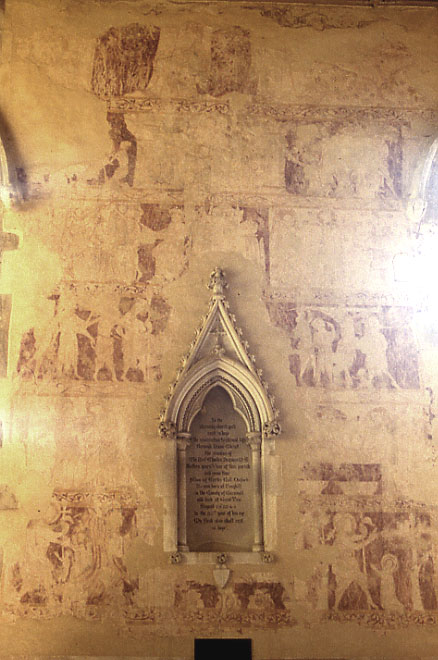
A large panel on the South Wall has Passion scenes arranged in tiers in strip format. A superimposed memorial tablet from a later period partly obscures them. The visible scenes are very good indeed and of the finest quality (whether in provincial church painting or elsewhere).
The scenes in the top tier have been reduced to vague patches of pigment, but presumably they were early incidents in the story, beginning with the Entry into Jerusalem. The scene furthest to the left in the second tier is possibly Christ washing the Disciples’s feet, given that a small figure, by deduction one of the Disciples, seems to be kneeling at the extreme right. One or more completely obscure scenes, possibly the Last Supper and the Agony in the Garden follow this to the right, after which comes what is almost certainly the Arrest in Gethsemane.
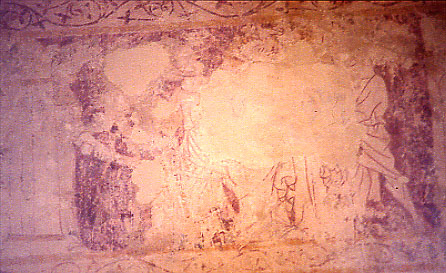
The central part of this has gone completely, and what is left is obscure, but in the detail above, at the right is part of a figure with the short tunic and bare legs of many figures in this painting, presumably one of the soldiers sent to arrest Christ Opposite this figure on the left of the scene is part of St Peter, who cut off Malchus’s ear, with his just-visible sword, but the central part of this section, which presumably showed Judas in the act of betraying Christ, has effectively gone.
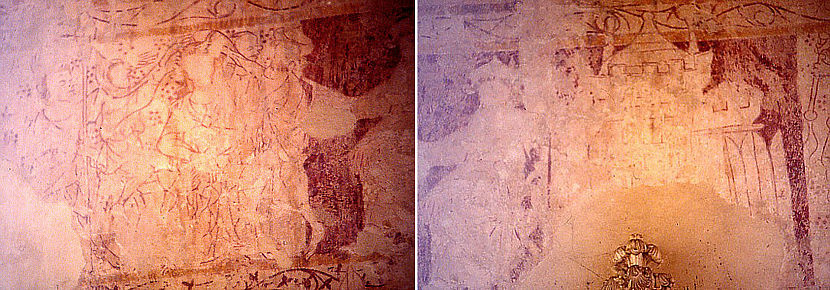
In the next tier down, (to the left of the apex of the large memorial tablet) and pictured above, is Christ before Pilate, who is partly visible seated at the right. The rest of this scene is only partly clear, but enough remains to show that the Crowning with Thorns is taking place in the centre. The four figures around Christ include one in what seems to be a pointed hood poised balletically at the second left, another with a staff evidently directing operations with an extended hand (far left), and a man whose face shows in profile at the back of the group.
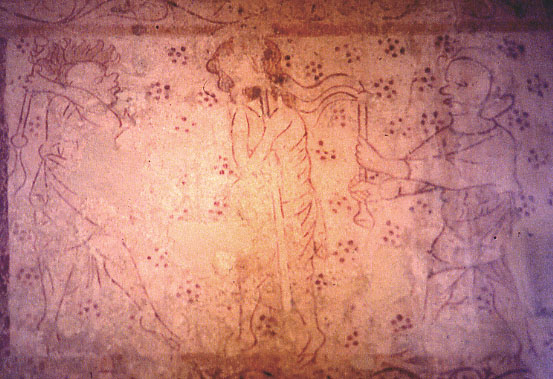
Beyond Pilate to the right and shown here below right is a rare glimpse of the architecture of Jerusalem. It has crenellated parapets and something like an ‘onion’ dome, flanked by pinnacles. What seems to be a kind of stockade in front of it is only partly preserved, but overall, the painter was evidently trying to suggest a foreign, eastern city with buildings unlike those familiar in medieval northern Europe.
Next on the right (right) is the Flagellation. Christ, bound with his crossed arms wrapped around the narrow pillar, stands in the centre. The torturer on the right, wearing the very short wrapped tunic characteristic of this painting, and some kind of headgear, wields a cat-o’-nine-tails scourge. As with most torturers in paintings of this type and subject, his facial features have been exaggerated into coarse ugliness. The same is true of the torturer on the left, who either has very strange hair, or wears a curious hat in the approximate shape of a coxcomb, such as jesters might wear. Bizzare hair is very common among torturers of Christ and the Saints, and there are several examples on this site.

In the next tier down, on the left, is the Road to Calvary, (above left) with two men, the leading one with a spear, flanking Christ in the centre, while another figure brings up the rear. The man in the lead may be wearing a flat-crowned hat, and he is turning to look behind him at Christ Beyond this, to the right of the triangular monument, is a much clearer scene (below, lower left), the Crucifixion itself. The Cross, with the dead or dying Christ, is centrally placed, with Stephaton offering the sponge at the right. Opposite him on the left is Longinus, according to the legendary accounts the blind soldier who pierced Christ’s side with his lance, regaining his sight as the spurting blood touched his eyes. Longinus, the lance still in his right hand, points dramatically with his left to his eye. A figure at the far left is either removing the nails from Christ’s hand or driving them in. It is impossible to be sure, since a certain amount of conflation of incident can often be seen in narrative paintings of the Crucifixion, especially where they involve Longinus (the most extreme example here is in the Passion Cycle at North Cove).
A small detail at the foot of the cross to the right, between Christ’s feet and Stephaton is intriguing. I think this might be intended for the skull and other bones, traditionally those of Adam, found in many frescoes, manuscript illustrations and easel paintings of the Crucifixion, but not elsewhere in English church wallpainting, so far as I know.
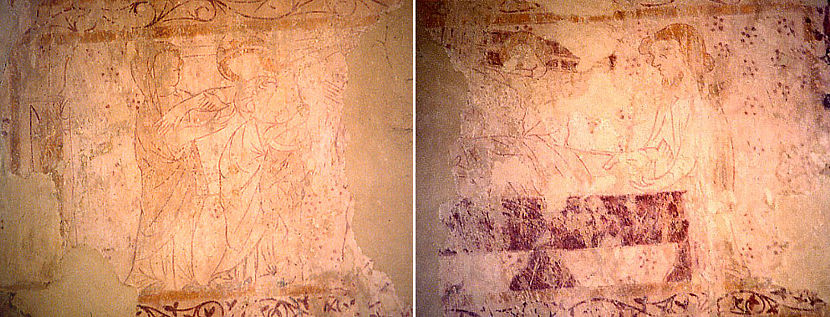
In the tier below, at the left of the memorial tablet, is the Deposition, with Christ being carefully taken down from the cross. In the centre, a male figure lifts Christ’s body, and here as in many other scenes the superior talent of this painter, who has managed very successfully to suggest the weight and the effort involved, is revealed. The figure standing at the left seems to be female, possibly Mary Magdalene or even the Virgin Mary herself. There was once a third figure at the right, but this has been reduced to part of one hand.
A suggestion of a building at the far left may have been the sepulchre, the interior of which appears in the Entombment, to the right of the memorial and shown above right. The standing man at the right is probably Joseph of Arimathea, setting Christ, already shrouded, on or into the tomb. A smaller figure behind the tomb is harder to identify, but I think it may be St John, arms raised and spread wide in an attitude of abandoned grief.
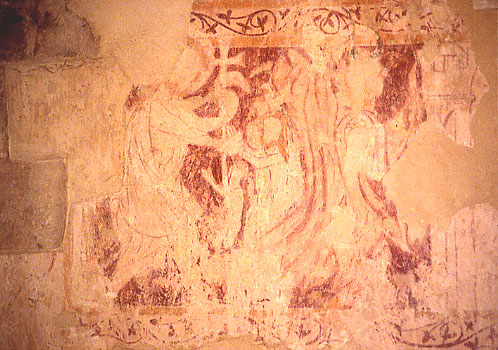
An Entombment, even one as incomplete as this, is a rare survival, as is the scene in the lowest tier at the left, the Harrowing of Hell (below, right).
It is not easy to see the Mouth of Hell which vertically spans the length of the scene at the centre right, but the small crowd of figures inside, led by one kneeling and holding out its arms to the giant Christ, who holds the banner of the Resurrection and clasps another figure, probably Adam by the hand, is rather clearer.
There are some obscure details further to the right, perhaps part of a crest on the head of the Hell-creature, and then part of another building, possibly an apartment of Hell, although this would be very unusual.
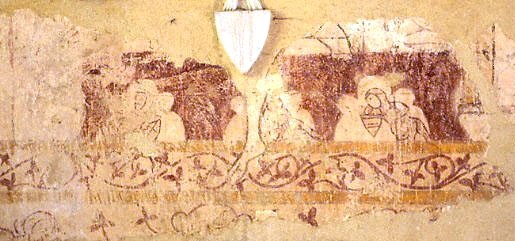
To the left is what remains of the Resurrection, most of which has disappeared below the memorial tablet (as in many other churches, the existence of the paintings was probably not suspected when it was set up), and is thus now reduced to Christ’s foot stepping out of the tomb and several tiny soldiers, the one on the right sleepily propped on his shield.
The difference is scale between the main figure and the others, obvious enough elsewhere in the cycle, is most marked of all here, and this particular scene must have been very impressive.
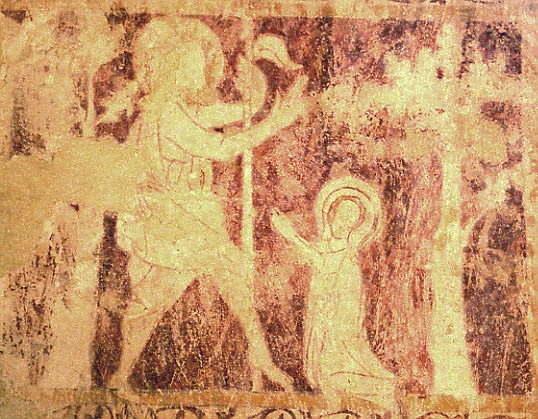
To the right of what is effectively the lowest tier is the very rare Appearance to Mary Magdalene, fortunately the clearest of all the scenes (below right) Two flourishing trees frame the scene, and Mary at the right kneels reverently before Christ, who stands with the banner of the Resurrection.
It is a very fine Cycle, comparable with that at Little Witchingham, which also has rarely found scenes. Other paintings are known to exist under plaster elsewhere in the church, awaiting uncovering when funds become available.
Website for St Michael & All Angels, Great Tew